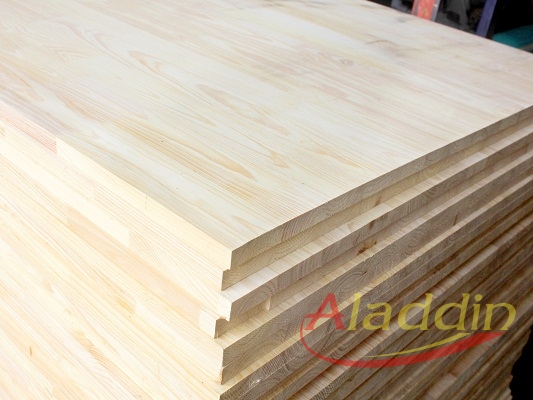I. Laminated wood is popular with many consumers because of its high aesthetics and reasonable price
1. What is laminated wood? Laminated wood is the result of joining natural wood bars together using modern machinery and technology to create a large wooden board.
2. What are the components of finger jointed wood?
As mentioned above, the main raw materials for producing finger jointed wood are natural wood bars from corn husks of workshops or small diameter wood that has been steamed, dried, sanded, pressed with modern advanced technology and painted with aesthetic coatings.
In addition, people also use Urea Formaldehyde (UF), Phenol Formaldehyde (PF) or Polyvinyl Acetate (PVAC) glues to increase the adhesion of wood.
In which, UF glue is a type of glue commonly used in furniture processing, while PE glue with a higher Formaldehyde content is used to process exterior materials.
3. Common types of laminated wood today
Based on the aesthetics and durability of laminated wood, laminated wood is divided into 3 basic types:
- A-quality laminated (AA): 2 A-sides
This is a product line with extremely good wood quality, with 2 sides and beautiful edges, harmonious colors. Therefore, you can freely choose colors and designs without having to worry about the quality of the wood panels.
- B quality bar (AB): 1 side A and 1 side B
Including a beautiful side A, no dead eye grafting error, the black seam is produced quite beautifully and carefully. But side B only has a relative aesthetic level, with short and medium black seams allowing for seams. The largest live eye is from 4 - 5cm, the standard allows small black eyes with an average diameter of less than 5mm. This type of finger jointed pine is commonly used in the production, as well as processing of finished wood products and home furniture items such as: cabinet doors, kitchen cabinets, ...
- Grade C (BC) finger joint: 1 side B and 1 side C
This is a type of finger joint with one side B allowing live knots, small black knots with an average diameter
II. Advantages and disadvantages of laminated wood
1. Advantages
- Laminated wood is recognized for the following outstanding advantages:
- Having undergone modern industrial processing steps, being carefully and strictly painted with aesthetic paint, it is not susceptible to termites, warping, shrinking or twisting.
- Contributing to the protection of primary forests and natural forests because the wood materials for producing laminated wood are mainly taken from planted forests.
- Diverse designs, many types of wood to choose from.
- With advanced and advanced processing techniques, the product has high color fastness, good scratch resistance, impact resistance and physical stability.
- Durability is not inferior to solid wood if the factory has good processing skills.
- Compared to solid natural wood, laminated wood is 20-30% cheaper
2. Disadvantages
Besides the above advantages, laminated wood still has the disadvantage of low uniformity of color and grain because it is made from many different pieces of wood. In addition, laminated wood is not as cohesive as natural wood, so it cannot produce fine art details such as motifs, patterns, etc.
III. Applications of laminated wood in interior design
Laminated wood is popular because it can be used to produce a lot in life instead of solid wood in the current situation of increasingly scarce and expensive solid wood:
- Manufacturing and producing household furniture such as beds, wardrobes, kitchen cabinets, etc.
- Making wooden floors, wooden wall panels in the house, in the room
- Producing shelves, hangers, etc.
- Homemade handicraft products, souvenirs.
- Making picture frames, painting frames, etc.
- Used as high-end auditorium chairs, cinema chairs.
- Designing and selling furniture in showrooms, cabinets, display shelves.






